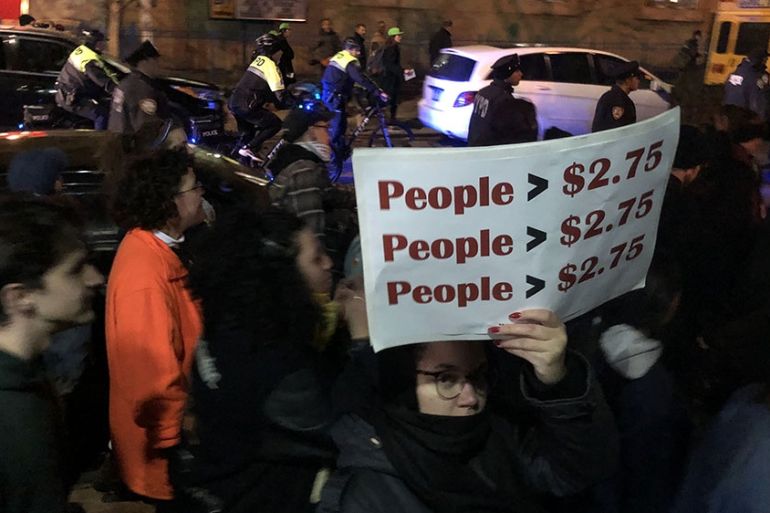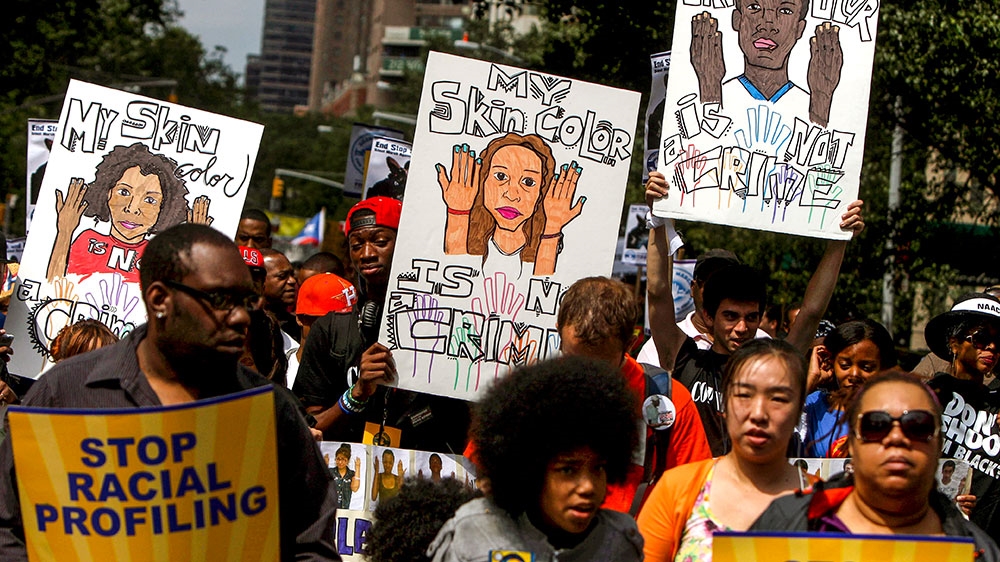NYPD crackdown on subway fare evasion ‘criminalises poverty’
Activists slam New York City effort to go after fare evaders and call for an end to police brutality.

New York City – Nineteen-year-old Adrian Napier sat on the subway car bench, hands held high as other passengers scattered to opposite ends of the car. On the train’s platform, about a dozen New York City Police Department officers – some with their weapons drawn – faced the car, readying themselves for the train’s doors to open.
“Will one of you call my mom,” Napier can be heard saying in a video of the October 25 incident.
Keep reading
list of 4 itemsTwo officers killed in suspected JI attack on Malaysian police station
Algerian man missing for 26 years found captive in neighbour’s cellar
Pro-Israel billionaires urged New York crackdown on Gaza protests: Report
Within seconds, the doors opened and officers rushed Napier, throwing him to the ground.
Police said Napier fled when they approached him for questioning after they received reports he had a gun. NYPD has not confirmed a gun was found. Napier, whom police reportedly say was “wanted for questioning related to past larceny”, was subsequently arrested for fare evasion.
In case you’re wondering how an arrest in NYC goes down. The guy has made absolutely no indication that he would flee or fight and wasn’t trying to hide.
If you can’t see, the reason everyone moved was because all the police had taken out their guns and aimed at him. pic.twitter.com/dAstrtMntz
— Elad Nehorai (@PopChassid) October 25, 2019
“This is a criminalisation of poverty, that’s basically what it is,” said Joseph, 21, at a recent rally against the NYPD crackdown on fare evaders and vendors in the subway system.
“A couple of months ago, we did not have this,” Joseph told Al Jazeera, requesting to go by only his first name.
New York Governor Andrew Cuomo earlier this year ordered 500 additional police officers to patrol the city’s subways to combat “attacks against transit workers and persistent fare evasion”.
But activists and some residents say the ensuing crackdown on fare evaders, many of whom may be unable to afford the $2.75 fare.
“This city is full of poor people in all communities and minorities and it is not OK to prioritise white people, to patronise tourists, to prioritise middle classes,” Frankie, who is Joseph’s sister, told Al Jazeera, also requesting only her first name be used.
Frankie and Joseph rallied with more than 1,000 others last month against police tactics in the subway system, the second protest of its kind in recent weeks.
Protesters point to incidents like that of Napier and others, saying the crackdown disproportionately affects minority communities.
‘What’s happening is rampant’
A report in August examining NYPD data found that nearly 90 percent of fare evasion arrestees are black or Latino.
Marz, who lives in Crown Heights above the subway station where last month’s incident occurred said she feels gentrification plays a role.
“We know that with gentrification comes increased police presence,” she said.
A report in January by the Community Service Society, a New York-based organisation, linked gentrification to an increased presence of NYPD members, with a higher number of stop and frisks, and more complaints in neighbourhoods with diverse populations registers to the city’s “311” non-emergency service phone line.
Marz is an organiser with Decolonize This Place, a grassroots decolonial action-oriented movement.

The movement has documented similar instances of people being arrested or questioned by police for seemingly normal behaviour.
A few days after Napier was arrested, a woman selling churros was surrounded by three uniformed NYPD officers and one plain-clothes officer, who told her she either has to turn over her car or face arrest. Crying, she was placed and handcuffs and eventually released with a summons.
Although individuals cannot sell food in the subway without a licence, the sight of a “churros lady” is as common and quintessential New York as the yellow taxi.
“This isn’t just about police brutality,” Marz said. “All New Yorkers have to deal with the MTA. What’s happening is rampant.”
MTA struggles with debt
Officials, however, say more police are needed to combat the increase in fare evaders – up from 1.8 percent of riders in recent years to 3.2 percent, according to local media.
The governor’s office said the lost revenue from fare evasion has also increased from $105m in 2015 to $225m in 2018.
This comes as the MTA struggles to modernise its transit system without going deeper into debt. The agency is currently facing a massive budget gap of $500 million for the next year. That could potentially skyrocket to one billion dollars over the upcoming three years, according to Bloomberg News.
Its most recent fare rise, which eliminated the discount for monthly and weekly passes was enforced in April.
Protests over fare hikes have a long history. Mass demonstrations erupted in 1948 after the MTA doubled the fare, which had been $0.05 for more than 40 years. By 2013, the fare was $2.50. And in 2015, the fare was raised to $2.75.
Fare rises, whether in the base fare or passes, disproportionately affect low-income families in New York, according to experts who say that people make decisions of everyday activities such as going to church or going out for fun based on the subway fare. And activists worry, increased police presence will only further criminalise minority groups in the city.
For movements such as Decolonize the Place, they are demanding a subway free of any cop presence at all.
“We’re not asking for less cops in the station, we’re not asking for police reform, we’re not asking for community affairs police officers, [or] police officers who are specifically trained to deal with the MTA,” Marz told Al Jazeera. “We are actually asking for absolutely no cops at all.”
As for Joseph and Frankie, who witnessed a young protester collapsing while being arrested on the day of a protest last month, the demand is to be treated fairly and free public transportation.
“We want fair treatment, we don’t want to be criminalised because we are poor,” said Frankie.
When reached, the MTA declined to comment on the issue, and the NYPD did not respond despite repeated follow-ups.